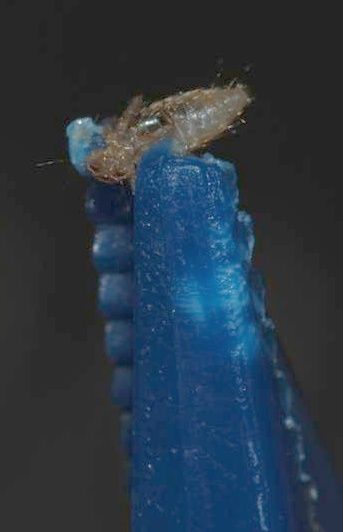Lice
General Information and Description
Common poultry lice are pests or ectoparasites infesting the skins of chickens. Lice are often 1/25 of an inch to ¼ inch long, and are straw-colored or yellowish brown. Lice are generally scavengers that feed on the dead skin.
Various species can inhabit different areas of a bird, and some birds are known to host up to 15 of these species. Female lice are more common than males. In fact, most species are classed as parthenogenetic, which means that they can reproduce without the males. Lice in birds, however, lay their eggs deep into feather shafts where they are inaccessible to their preening.
Range
Lice are generally host-specific and spend their entire life cycle in one host. Bird or chicken lice won’t infect humans or pet dogs, but they are contagious among fellow fowl. If you have a flock of them in your backyard and you discover one with lice infestation, there’s a high risk that almost all of them are already infested. Lice population in poultry farms tends to reach its peak during the autumn and winter months.
Method of Kill
Chicken lice are not known to transmit bird pathogens. Some, however, believe that certain kinds of bird lice can actually cause microbial diseases in their hosts. The presence of lice in chickens can significantly diminish overall poultry health, and are known to result in unproductive hens. Chicks and growers suffer the most as they can suffer from severe sleep disruption from annoying lice activity in their bodies.
Prevention & Treatment
In general, lice infestation often happens in unclean areas. It can also happen when in the company of one that has been infested. That’s because lice can jump from one host to another. Hence, two things are needed to control lice infestation in your backyard. First, make sure your chicken coops and pens are clean. And second, do regular random checks for lice infestation and, once found, perform the proper delousing solutions.
Your chickens should be checked for lice every two weeks. Spread their feathers in the breast, thigh, and under the wings and look for adult lice and their nits. Just one is enough to start immediate chemical insecticide treatment. The self-grooming that chickens do with their beaks can dislodge lice, but their eggs or nits are problematic since they are glued to the feather base and shaft. You can also induce molting since it is another natural way to reduce infestation. Be sure, however, to immediately remove nit-infested feathers from your poultry grounds.
Lice pesticide solutions are also a great way to solve the problem. These come in the form of powders, dusts, resin strips, and liquid sprays. These pesticides include pyrethrins, organic phosphates, and pyrethroids carbonate (Sevin dust or Carbaryl spray). Just make sure to follow the instructions and avoid feed and water contamination. Some discussions on treating and preventing lice infestation are here.
General Information and Description
Common poultry lice are pests or ectoparasites infesting the skins of chickens. Lice are often 1/25 of an inch to ¼ inch long, and are straw-colored or yellowish brown. Lice are generally scavengers that feed on the dead skin.
Various species can inhabit different areas of a bird, and some birds are known to host up to 15 of these species. Female lice are more common than males. In fact, most species are classed as parthenogenetic, which means that they can reproduce without the males. Lice in birds, however, lay their eggs deep into feather shafts where they are inaccessible to their preening.
Range
Lice are generally host-specific and spend their entire life cycle in one host. Bird or chicken lice won’t infect humans or pet dogs, but they are contagious among fellow fowl. If you have a flock of them in your backyard and you discover one with lice infestation, there’s a high risk that almost all of them are already infested. Lice population in poultry farms tends to reach its peak during the autumn and winter months.
Method of Kill
Chicken lice are not known to transmit bird pathogens. Some, however, believe that certain kinds of bird lice can actually cause microbial diseases in their hosts. The presence of lice in chickens can significantly diminish overall poultry health, and are known to result in unproductive hens. Chicks and growers suffer the most as they can suffer from severe sleep disruption from annoying lice activity in their bodies.
Prevention & Treatment
In general, lice infestation often happens in unclean areas. It can also happen when in the company of one that has been infested. That’s because lice can jump from one host to another. Hence, two things are needed to control lice infestation in your backyard. First, make sure your chicken coops and pens are clean. And second, do regular random checks for lice infestation and, once found, perform the proper delousing solutions.
Your chickens should be checked for lice every two weeks. Spread their feathers in the breast, thigh, and under the wings and look for adult lice and their nits. Just one is enough to start immediate chemical insecticide treatment. The self-grooming that chickens do with their beaks can dislodge lice, but their eggs or nits are problematic since they are glued to the feather base and shaft. You can also induce molting since it is another natural way to reduce infestation. Be sure, however, to immediately remove nit-infested feathers from your poultry grounds.
Lice pesticide solutions are also a great way to solve the problem. These come in the form of powders, dusts, resin strips, and liquid sprays. These pesticides include pyrethrins, organic phosphates, and pyrethroids carbonate (Sevin dust or Carbaryl spray). Just make sure to follow the instructions and avoid feed and water contamination. Some discussions on treating and preventing lice infestation are here.


 BACK to Predators
BACK to Predators
